Class 4 Maths - Geometry - CBSE Worksheets Solutions
Q1: Write the shape of the following objects:
(i) Tree trunk ______.
Ans: cylinder.
(ii) Sugar cube ______.
Ans: cube.
(iii) Carrot ______.
Ans: cone.
(iv) Football ______.
Ans: sphere.
(v) Fire extinguisher ______.
Ans: cylinder.
(vi) Shoe box ______.
Ans: cuboid. Q2: Answer the following questions:
Q2: Answer the following questions:
(i) Name any four objects which look like a cone.
Ans: Party hat, Ice cream cone, Funnel, Traffic cone, Waffle cone.
(ii) Name any four objects which look like a cuboid.
Ans: The lunch box, Bricks, Shoebox, Book, Carton boxes.
Q3: Fill in the blanks:
(i) A cube has ______ edges.
Ans: 12
The edge of a cube is the line segment joining the two vertices. There are a total of 12 edges in a cube.
(ii) A cylinder has ______ edges.
Ans: 2
A cylinder has 3 faces - 2 circle ones and a rectangle (if you take the top and bottom off a tin can then cut the cylinder part on the seam and flatten it out you would get a rectangle). It has 2 edges and no vertices (no corners).
(iii) A cuboid has ______ faces.
Ans: 6
Like a cube, a cuboid has 6 faces, 8 vertices, and 12 edges.
Q4: Connect the lines from the 2D shapes with the matching 3D form. 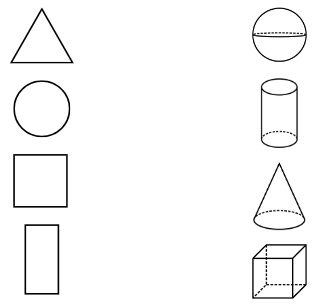
Ans: 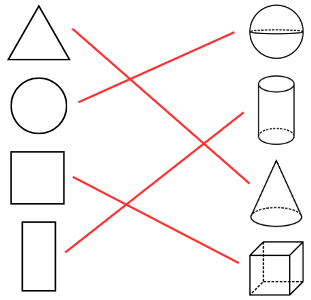
Q5: Tick (✓) the open figures and cross the closed figures: Ans:
Ans:

Q6: Tick (✓) the polygons which are triangles: Ans:
Ans:

Q7: Draw a rough sketch of a:
(i) A polygon having 6 sides
Ans: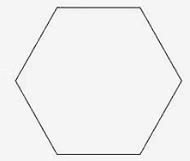
(ii) Triangle
Ans: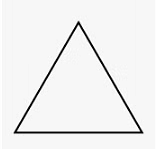
(iii) Quadrilateral which is not a square or a rectangle.
Ans:
Q8: Name the line segments in each of the following figures:
(i)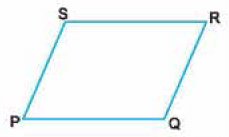
(ii)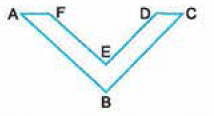
(iii)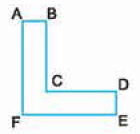
Ans:
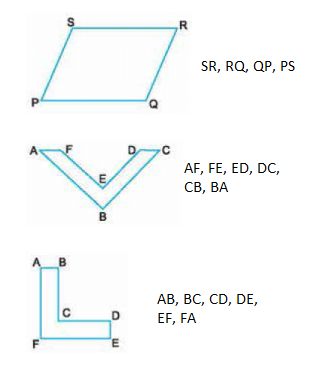
Q9: In the figure, name: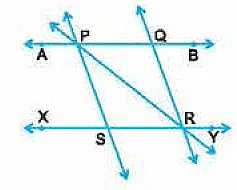 Ans:
Ans: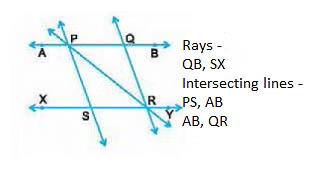
Q10: Name the points marked between A and B. Ans:
Ans:

Q11: State true or false:
(i) A point has no length no breadth and no thickness.
Ans: True
(ii) A ray has no definite length.
Ans: True
(iii) A line has two end points.
Ans: True
Q12: In the figure, name the following: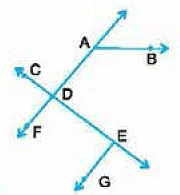
(i) Pair of intersecting lines
(ii) 4 rays
Ans:
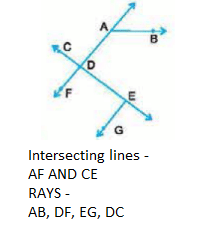
Q13: Give three example from your environment for each of the following:
(i) a pair of parallel lines
Ans: Railway track lines, window lines,wicket sticks in cricket match.
(ii) a pair of perpendicular lines
Ans: In real life, the following are examples of perpendicular lines: Football field. Railway track crossing. First aid kit.
Q14: Find the radius of the circle whose diameter is:
Diameter = radius/2
(i) 12 cm
Ans: = 12/2 = 6cm
(ii) 4 cm
Ans: = 4/2 = 2cm
Q15: Find the diameter of the circle whose radius is:
Radius = 2 x diameter
(i) 8 cm
Ans: = 8 x 2 = 16cm
(ii) 3 cm
Ans: = 3 x 2 = 6cm
|
33 videos|168 docs|30 tests
|
FAQs on Class 4 Maths - Geometry - CBSE Worksheets Solutions
| 1. What are the basic geometric shapes? |  |
| 2. How do you calculate the area of a triangle? |  |
| 3. What is the Pythagorean Theorem? |  |
| 4. How do you find the circumference of a circle? |  |
| 5. What is the difference between perimeter and area? |  |





















